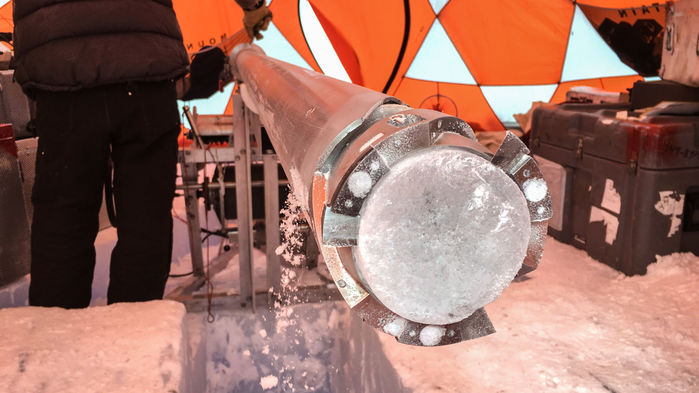Ice age 2.7 million years revealed the features of the Earth’s climate in the distant past

A few days ago, a group of scientists told about an interesting discovery: in Antarctica, it was possible to obtain a sample of ice, which, according to estimates by glaciologists, is 2.7 million years old. This is as much as 1.7 million years more than the previous record. The value of this ice is that it is a canned sample of water and gases, from which it is possible to understand what climatic conditions were on Earth in its past. Frozen gas bubbles in ice help scientists determine the composition of the atmosphere that existed on the planet millions of years ago. Just then, about three million years ago, something happened that contributed to the onset of ice and the general cooling of the climate.
The value of this sample is incredible, says David Schuster, a geochemist at the University of California, Berkeley. "This is the only sample of the ancient atmosphere of the Earth, which we now have," - said the scientist. This is true, plus obtaining a sample of ice of this age is associated with a number of purely technological difficulties: the well must be very deep, and it is necessary to drill in extreme conditions. Plus, the ancient ice is quite difficult to find, careful analysis of glaciers in different regions of the Antarctic is required.
Experts have already managed to analyze the air from the frozen bubbles in the ice. As it turned out, the carbon dioxide content of 2.7 million years ago was about 300 parts per million, which is significantly lower than the current figure. According to a number of climatologists, it is the relatively low content of carbon dioxide in the Earth’s atmosphere that contributed to the onset of cooling. Previously, the composition of the atmosphere was determined by the fossil remains of animals and plants. But this is a very inaccurate analysis, which, by the way, showed a higher content of carbon dioxide in the atmosphere than has been determined now.
')
It is clear that the results obtained need to be rechecked. But if they are fair, then scientists will have to rebuild some parameters of paleoclimatic models. The fact that scientists have discovered such an ancient sample of ice suggests that similar discoveries are possible in the future, maybe scientists will be able to find even older samples. As a result, experts will be able to build more accurate paleoclimatic models than those that exist now. In addition, in some cases, climatologists and their colleagues find it difficult to say what was the composition of the atmosphere millions of years ago.
Scientists prefer to select ice samples in Greenland and Antarctica. Usually, to obtain truly ancient samples, it is necessary to drill in regions where ice accumulates for a long time. In this case, climate change can be tracked by layers, as by the tree's annual rings track the conditions in which the tree grew. Only the years here can not be traced, but the millennia - without problems. In the case of ice, scientists also analyze the gases included in the ice and the ice itself, more precisely, water. At the moment, the oldest sample was considered to be ice raised from the bottom of a well in the Antarctic in 2004.
 Ancient ice was discovered in East Antarctica, 200 km from McMurdo station . This is the largest settlement, port, transportation hub and research center in Antarctica. It belongs to the US Antarctic Program, but also serves the stations and research programs of other states. In this region there are deposits of so-called blue (or blue) ice , which accounts for only 1% of the total ice in the Antarctic. It is formed as a result of compression of the fallen snow, which becomes part of the ice on which it is located. When pressed in the ice, gas bubbles remain, the ice crystals increase, which gives the ice a blue or even blue color.
Ancient ice was discovered in East Antarctica, 200 km from McMurdo station . This is the largest settlement, port, transportation hub and research center in Antarctica. It belongs to the US Antarctic Program, but also serves the stations and research programs of other states. In this region there are deposits of so-called blue (or blue) ice , which accounts for only 1% of the total ice in the Antarctic. It is formed as a result of compression of the fallen snow, which becomes part of the ice on which it is located. When pressed in the ice, gas bubbles remain, the ice crystals increase, which gives the ice a blue or even blue color.Soon, scientists will make a new attempt to break into the past of the Earth with the help of frozen water. This time, they hope to get a sample of ice aged 5 million years, when the concentration of carbon dioxide is believed to be above 300 parts per million. According to some experts, ice in the Antarctic began to form about 30 million years ago (in some regions). Probably so ancient samples can not be found, because the ice is unlikely to remain unchanged all these tens of millions of years. But ice age of 3-5 million years, you can probably find.
Source: https://habr.com/ru/post/373731/
All Articles